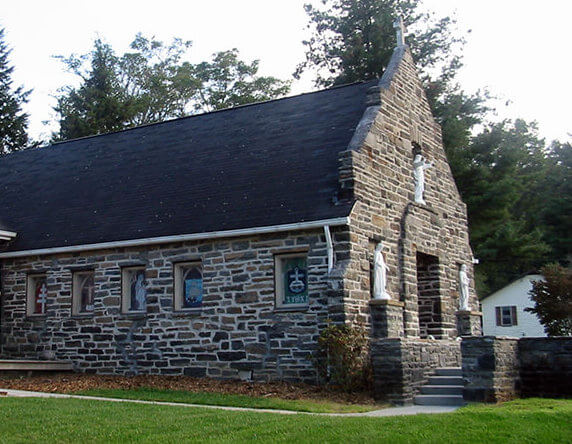From Old St. Joseph Church, the first Catholic church built in western North Carolina, to Belmont Abbey Basilica, Monastery and College, our diocese is filled with decades of stories, architecture and landmarks of faith. Learn more about the history of Catholicism in western North Carolina by visiting these significant points of interest – treasured places that attest to the faith, hope and perseverance of people who helped plant the roots of our local Church.
Treasured Sites
Belmont Abbey Basilica, Monastery and College
Belmont Mount Holly Road, Belmont Belmont Abbey is a monastery of Benedictine monks founded in 1876 that follows the Rule of St. Benedict of Nursia, who initiated western monasticism in the sixth century. The Basilica of Mary Help of Christians is the central structure on the campus of Belmont Abbey and is listed on the National Register of Historic Places. The basilica was built in neo-Gothic style in 1892, and was completely renovated in 1965. St. Katharine Drexel was one of its benefactors. It features prize-winning painted glass windows and a unique baptismal font made from an old slave auction stone. In 1998 the church was named a minor basilica by St. John Paul II. Its cemetery contains the graves of Abbot Leo Haid, founding abbot of the monastery, and two of the diocese’s former shepherds: Bishop Michael Begley and Bishop William Curlin. Belmont Abbey College, founded by the monks in 1876, educates students in the liberal arts and sciences so that “in all things God may be glorified.” Exemplifying Benedictine hospitality, it welcomes students from diverse ethnic, cultural, and religious backgrounds.
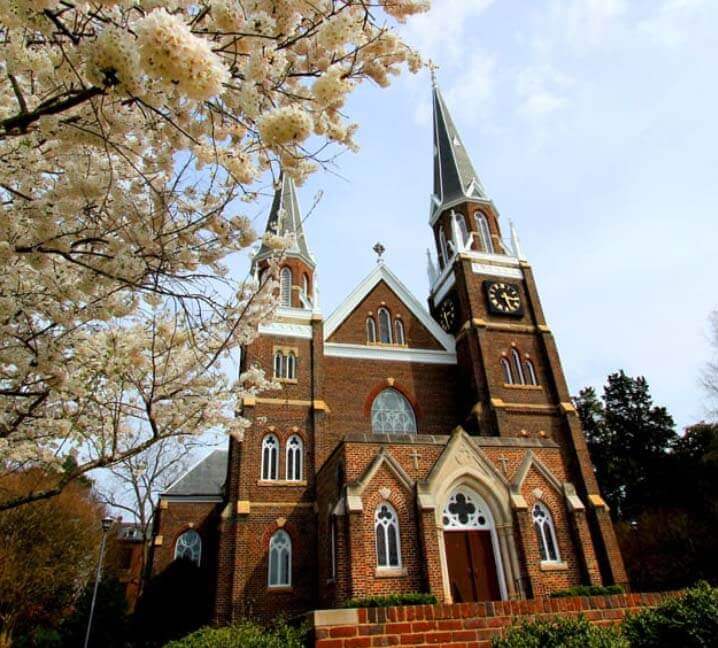
St. Lawrence Basilica
Asheville, NC 28801 St. Lawrence Basilica – one of two minor basilicas located within the Diocese of Charlotte – was designed and built in 1905 by renowned Spanish architect Rafael Guastavino. Pope John Paul II elevated the status of the church to a minor basilica in 1993. It is the only basilica in western North Carolina and is on the National Register of Historic Places. The red brick building, built in the Spanish Renaissance style, is capped by a copper dome that is guarded by statues of St. Lawrence, St. Stephen and St. Aloysius Gonzaga. The stunning 82-foot-by-58-foot dome, constructed of terracotta tile, is one of the largest free-standing elliptical domes in North America. It features the same vaulting technique and herringbone tile pattern that Guastavino used at Grand Central Terminal and Ellis Island’s Registry Room, as well as 200-plus other locations in New York City, and at Asheville’s Biltmore House.

St. Patrick Cathedral
Dilworth Road East, Charlotte Construction on St. Patrick Church began on March 17, 1938, St. Patrick’s Day, thanks to a donation from John Henry Phelan in honor of his parents. it was built adjacent to the O’Donoghue School (now St. Patrick School), which had relocated to the Dilworth neighborhood in 1930. Frank E. Frimmer of Austria designed the edifice, and stained glass windows were produced by the Henry Keck Studio in Syracuse, N.Y. It was dedicated by Raleigh Bishop Eugene J. McGuinness on Sept. 4, 1939, and it became a parish church in 1942. In the weeks leading up to the diocese’s formation, Bishop-elect Michael J. Begley selected St. Patrick Church as the cathedral for the new diocese, and the newly elevated cathedral served as the location for his ordination and installation on Jan. 12, 1972. The interior was extensively remodeled in the late 1970s and again in 1996. Additional renovations in 2012 returned the tabernacle to the center of the sanctuary and relocated the cathedra (bishop’s chair). A new staircase was built in 2013. It is listed on the National Register of Historic Places.
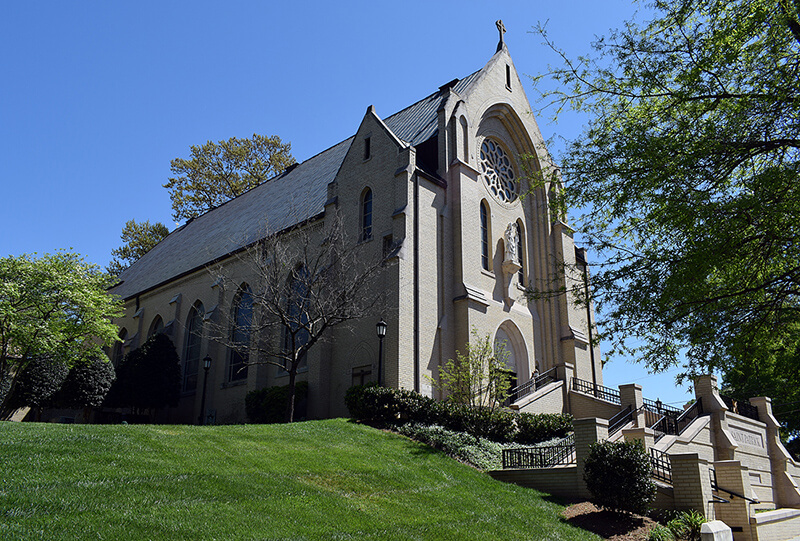
St. Peter Catholic Church
South Tryon Street, Charlotte Established in 1851, St. Peter Catholic Church is the oldest active parish in the diocese. Staffed in early times by the Benedictines and by the Jesuits since 1986, St. Peter has reflected the rich tapestry of the Catholic Church since its founding. The original building stood for 41 years before it became structurally unsafe, due to a munitions explosion at the close of the Civil War that damaged the foundation. In 1893, under the sponsorship of the Benedictines of Belmont Abbey, the cornerstone was laid for the current Gothic-style church. St. Katharine Drexel contributed to the purchase of pews for the church, contingent on a promise that they would be reserved for the “colored” people, in fulfillment of her mission’s order. In 1986, the diocese entrusted the parish to the Society of Jesus, the Jesuits. The parish embraces the tradition of Ignatian spirituality. As Charlotte’s center city Catholic church, St Peter serves the uptown Charlotte business community, young adults and families who live uptown, city visitors, and our brothers and sisters who struggle living on the margins.
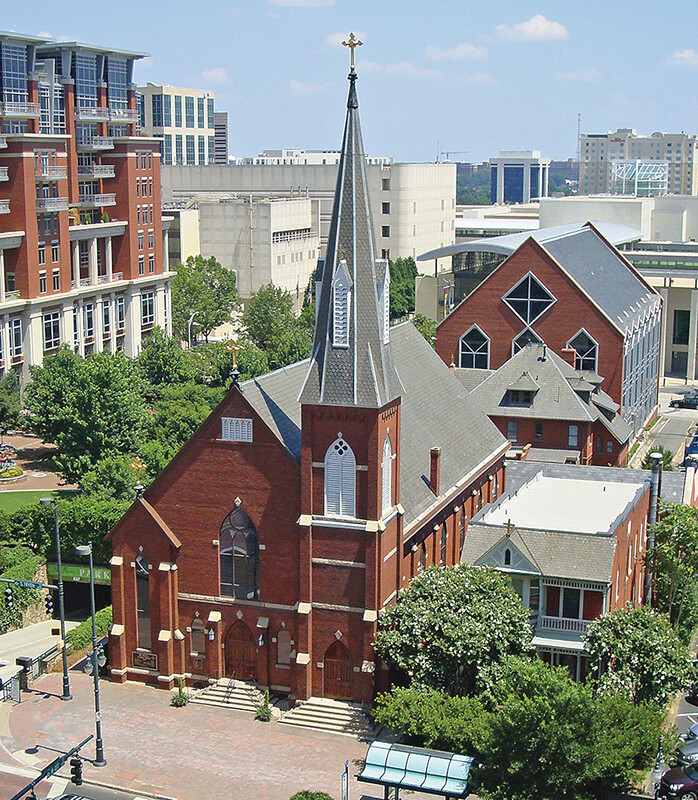
Old St. Joseph Catholic Church
Mount Holly, NC Built in Mount Holly in 1843 – the first Catholic church in North Carolina constructed west of Raleigh – humble Old St. Joseph Catholic Church is the mother Church for Catholics in western North Carolina. It is a Greek Revival style wooden frame building built by and for the local Irish immigrants. In the parish cemetery are the graves of many of the first Catholic families in western North Carolina and their beloved first pastor Fr. T.J. Cronin. Its third pastor was Fr. J.J. O’Connell, who later purchased the 500 acres of land in Gaston County that would become Belmont Abbey. Its parish rolls dwindled with the opening of St. Peter Church in Charlotte and the impacts of the Civil War. Critical repairs and renovations to the neglected church were made in 1974 and 2018. No longer an active parish, the church is under the care of Queen of the Apostles Church in Belmont and is listed on the National Register of Historic Places. It is opened for special occasions including the feasts of St. Patrick and St. Joseph each year.
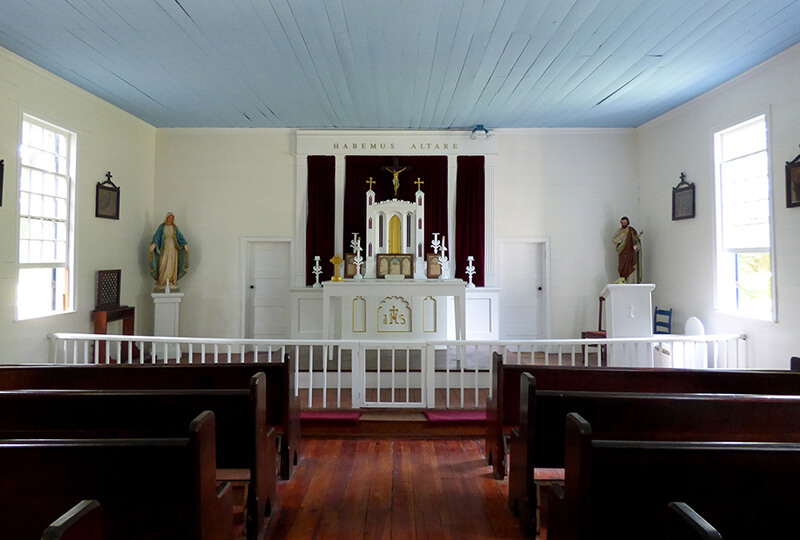
St. Joseph College Seminary
Arctus Ave, Mount Holly St. Joseph College Seminary is a minor seminary for the Diocese of Charlotte founded by Bishop Peter Joseph Jugis on the Solemnity of St. Joseph, March 19, 2016. Placed under the patronage of St. Joseph, the name also reflects the heritage of the diocese which was first shepherded by Bishop Michael Joseph Begley when it was created from the Diocese of Raleigh in 1972. The building’s award-winning architecture is of Christian pointed (also called Gothic) design. The seminary houses up to 40 young men who pursue an undergraduate degree at nearby Belmont Abbey College while discerning a vocation to the priesthood and living in a Benedictine-inspired community.
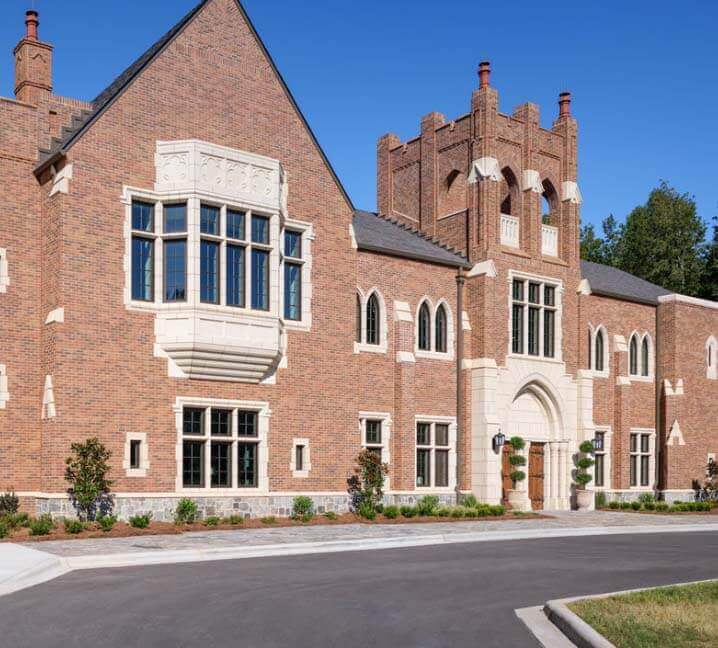
St. Joseph Vietnamese Catholic Church & Outdoor Stations of the Cross
Sandy Porter Road, Charlotte St. Joseph Vietnamese Catholic Parish is the first predominantly Vietnamese congregation in the diocese. The church is unique for another reason: its 16 larger-than-life Stations of the Cross (depicting the 14 usual Stations of the Cross, plus two more: the Nativity and the Resurrection). Ringing the church property, each station stands 6 feet tall or higher and weighs more than 16 tons.
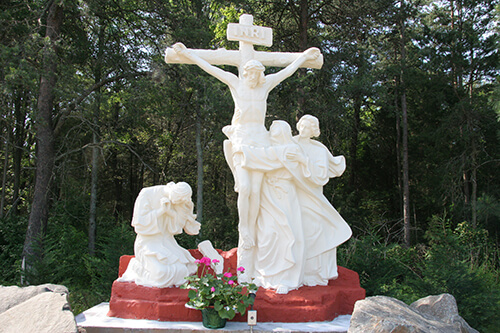
Our Lady of Grace Catholic Church
West Market Street, Greensboro Our Lady of Grace Catholic Church is a Gothic Revival church designed by renowned architect Henry V. Murphy of New York. Its 1952 dedication was attended by dignitaries including Raleigh Bishop Vincent Waters and Archbishop Amleto Cicognani, the Vatican’s apostolic delegate to the United States. Then-Msgr. Michael Begley was serving as pastor there when the call came from the pope in 1971 appointing him founding bishop of the Charlotte diocese. In 1976, Venerable Archbishop Fulton Sheen – a prolific writer, theologian, preacher and Emmy Award-winning media personality – visited to bless the parish’s new school and activity center.
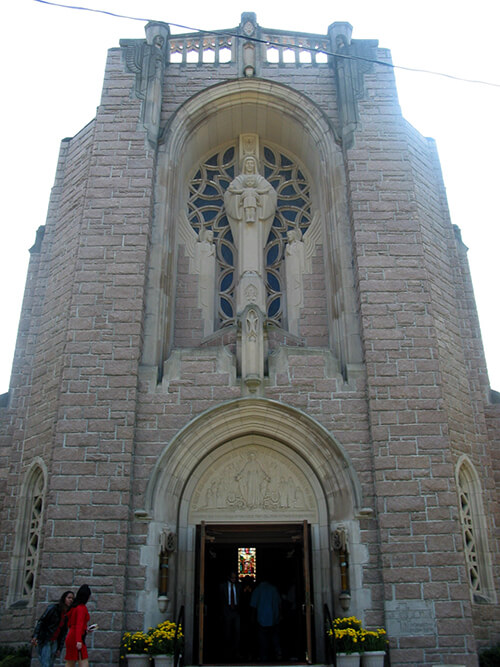
Our Lady of Lourdes Catholic Church and outdoor Lourdes Grotto
Deese Street, Monroe Our Lady of Lourdes Catholic Parish was founded in 1942 and faced the challenges of being a pioneer parish. Construction of the first church began in 1945 and it was dedicated by Bishop Vincent Waters in 1946. On Divine Mercy Sunday in 2004, the parish dedicated its new, larger church building across the street from the original church. The current church’s interior features dramatic murals that speak to its diverse population and colorfully illustrate aspects of salvation history. Additionally, the parish property features a beautiful outdoor Lourdes Grotto that served as the site for over a year for outdoor Masses during the pandemic. Bishop Peter Jugis was serving as pastor of Our Lady of Lourdes when he received the call from Pope John Paul II in 2003 appointing him the fourth bishop of the Charlotte diocese. Please contact the office to arrange a tour of the church. The outdoor Grotto is always open for prayer and pilgrimage.
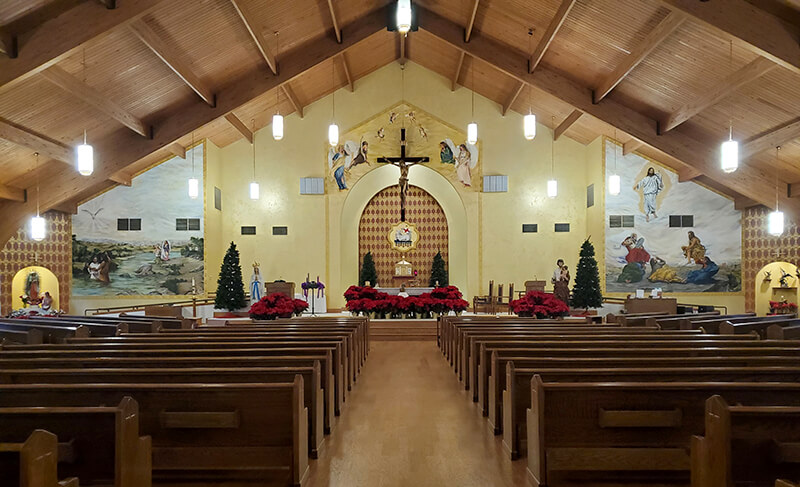
St. Helen Catholic Mission
Dallas Spencer Mountain Road, Gastonia Located in historic Spencer Mountain, St. Helen Catholic Mission is the oldest predominately African American Catholic community in the diocese. The red brick structure was designed by Benedictine Father Michael McInerney, a renowned church architect, in the mid-1910s. The site for the church – and, in part, its inspiration – came from Robert Gardin, a local who converted to the Catholic Church after having a dream in which St. Peter encouraged him to embrace the Catholic faith. Gardin’s conversion is said to have brought hundreds of friends, family and neighbors to the church. By the mid-1930s, black Catholics in the region gravitated to St. Helen’s. The parish remained in the care of the Benedictine monks for decades until it was placed under the administration of the Diocese of Raleigh and the pastoral support of neighboring parishes. Since 2000, it has been a mission of Our Lady of Consolation Catholic Parish in Charlotte.
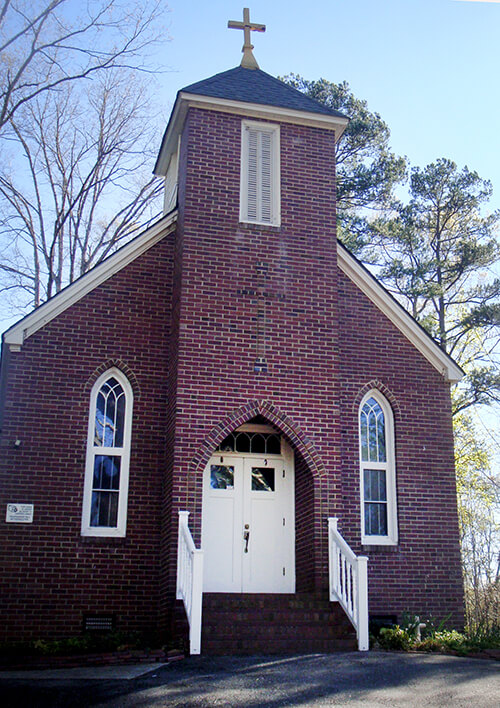
Sacred Heart Catholic Church
Lumen Christi Lane, Salisbury
Almost a century before a Catholic diocese was established in North Carolina, a small group of Rowan County Catholics gathered in Salisbury to celebrate their faith. That early presence led to the foundation of Sacred Heart Catholic Parish. In 1881, Salisbury Catholics welcomed their first resident pastor whose task it was to build a church in town, which was dedicated and named in honor of the Sacred Heart in 1882. Benedictine monks assumed responsibility for Salisbury when Abbot Leo Haid became apostolic vicar of North Carolina in 1887. The Sisters of Mercy opened a private convent-school in 1910 nearby. Through negotiations between the sisters and Raleigh Bishop Eugene McGuinness, the school became a parish institution in the early 1940s. A new Salisbury parish, Our Lady of Victories, was established in 1942 to serve black Catholics in the area; that community later merged with Sacred Heart. In 2003, the parish bought a 40-acre tract on Lumen Christi Lane for the present church building, school and parish cemetery.
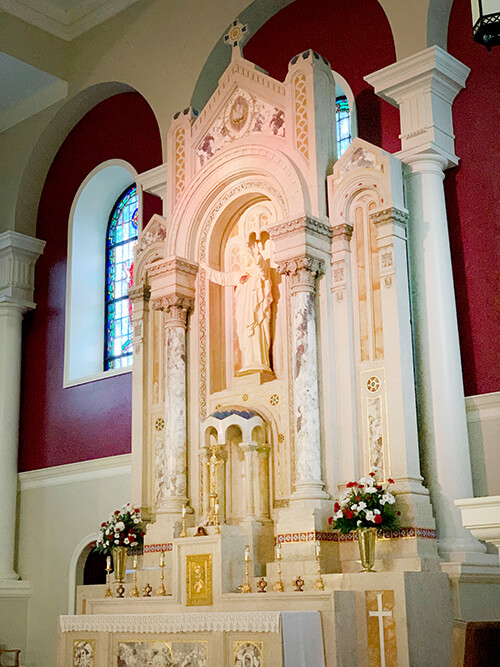
St. Leo the Great Catholic Church
Springdale Avenue, Winston-Salem St. Leo the Great Parish is the oldest in the Winston-Salem Vicariate. With roots going back to the late 19th century, its early history tells the tale of the small yet faithful community of Catholics in the Winston-Salem area – served by the Benedictine monks of Belmont Abbey who celebrated Mass in people’s homes. Eventually, the faithful were able to build a church in the 1890s under the leadership of Benedictine Abbot Leo Haid, who had been appointed apostolic vicar of North Carolina by Pope Leo XIII. Under the leadership of these two great Leos, the parish would seek the patronage of a third Leo: St. Leo the Great. By 1916 plans were under way to build a new church, designed by renowned church architect, Benedictine Father Michael McInerney. With the aid of the local Knights of Columbus, leading families of the parish, and many local Protestants, construction began in 1927. Bishop William Hafey of Raleigh placed the cornerstone on Jan. 15, 1928, and the church was completed in 1929. A local Catholic school, Villa Maria Anna, opened in 1947, followed by St. Leo the Great School in 1954 and Bishop McGuinness High School in 1959.
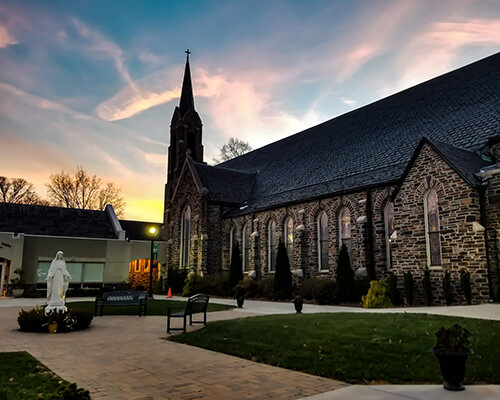
St. James the Greater Catholic Church
Manor Avenue Southwest, Concord St. James the Greater Parish is the oldest in the Salisbury Vicariate. Catholicism was introduced into Cabarrus County by Joseph Barnhardt, a Lutheran who was received into the Catholic Church along with his family in 1842. Due to the missionary work of visiting priests, within 25 years nearly all of the settlement embraced the Catholic faith. Barnhardt dreamed of having a church in the community instead of holding liturgies in homes; however, he died in 1858 before making any plans. On June 1, 1869, his father-in-law, George C. Goodman, deeded a picturesque plot of land on Gold Hill Road where the first St. James Catholic Church was built. On Aug. 1, 1869, Bishop James Gibbons, then apostolic vicar of North Carolina, dedicated the church. It was the first mission the Benedictines of Belmont Abbey accepted outside of Gaston County. After a fire destroyed the church on Gold Hill Road in 1954, Raleigh Bishop Vincent Waters built and dedicated a new church on Union Street in the City of Concord. Later, as the parish grew and moved to a new location, Bishop Peter Jugis dedicated the new church on Manor Avenue in December 2004. The parish maintains perhaps the oldest cemetery in the diocese, located at the former church’s site on Gold Hill Road.
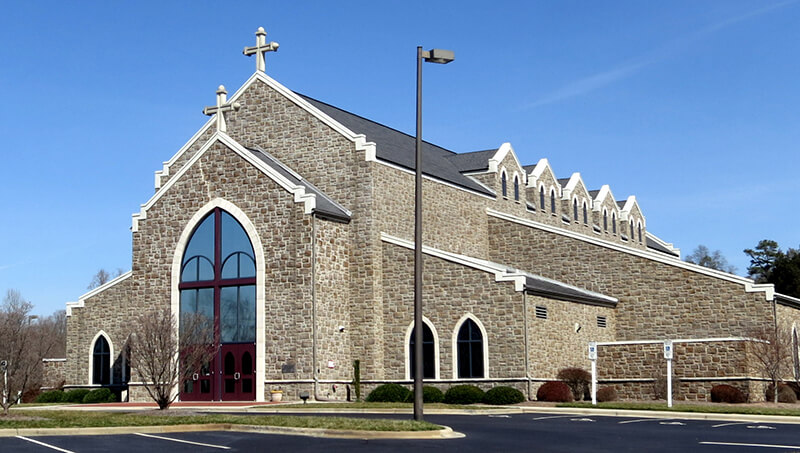
St. Benedict Catholic Church
West Smith Street, Greensboro
St. Benedict Catholic Parish, the oldest in the Greensboro Vicariate, is known as “The Mother Church of Greensboro.” The first Catholic Mass celebrated in Greensboro dates back to the 1870s – very few Catholics lived in Greensboro at the time, and traveling Benedictine priests from Belmont Abbey said Mass in people’s homes. Construction began in 1877 on the first church, named St. Anne’s and later St. Benedict’s in honor of the Benedictine monks who ministered to the community. The cornerstone was laid by Bishop James Gibbons, who had been elevated to Bishop of Richmond, Va., after serving as apostolic vicar of North Carolina. The original church was sold to the City of Greensboro in 1899 and the church moved to its current site situated between North Elm and Smith streets. St. Katharine Drexel gave the parish $1,500 to help build the current church, stipulating that a certain amount of pews should be reserved for African-American parishioners and encouraging the church to have an integrated congregation during the era of racial segregation in the U.S.
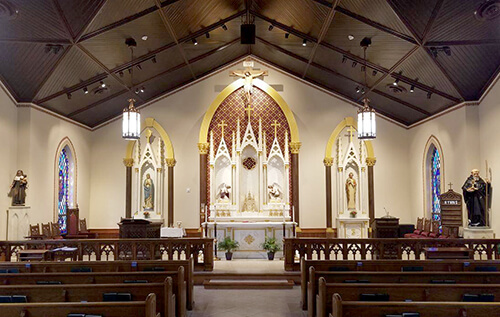
Holy Angels Catholic Church
North Main Street, Mt Airy
Built in 1921, Holy Angels Catholic Church is a witness to the stability and faith of the Catholic community in Surry County. In the early years of the 20th century, clergy from Winston-Salem ministered to the 10 or so Catholics living in Mount Airy at the time. Until 1919, local Catholics either traveled to St. Leo the Great Church in Winston-Salem or welcomed clergy from the town into their homes and a local opera house for Mass. By the mid-1910s, sporadic visits by Benedictine priests since 1907 were insufficient to minister to the rising Catholic population. Addressing the need for a permanent place of worship, Bishop Leo Haid, the Benedictine abbot of Belmont Abbey and apostolic vicar of North Carolina, purchased a site for a new church on Main Street in 1919. In 1921, Haid dedicated the church, which had been constructed of granite from the famed Mount Airy quarry. The Great Depression of the 1930s brought financial hardships to the area, and the church came close to shutting down. The parish recovered, and by the 1950s a number of converts added to the county’s growing Catholic population. The award-winning historic interior of the church remains largely preserved, and a collection of about 200 saints’ relics is available for public veneration.
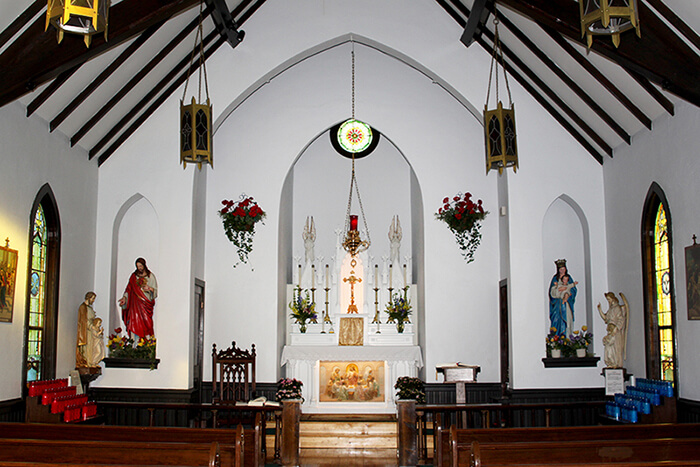
Our Lady of Guadalupe Catholic Church
Tuckaseegee Road, Charlotte Our Lady of Guadalupe Catholic Church, home to the diocese’s largest Hispanic Catholic community, developed from the diocese’s Hispanic Ministry outreach dating back to the early 1970s and the establishment of a Hispanic Catholic Center whose purpose was to unite the local Hispanic community with the diocese through liturgies, catechetical programs and more. The parish is noted for its Marian devotion, and its church features a beautiful Marian Grotto as a peaceful refuge for prayer and meditation.

St. Aloysius Catholic Church
2nd Street Northeast, Hickory Although a small Catholic community existed in Catawba County during the late 19th century, the first Mass was not celebrated there until 1913. Bishop Leo Haid of Belmont Abbey, apostolic vicar of North Carolina, assigned missionary priests to offer Masses in homes before dedicating a former Seventh Day Adventist church as the new St. Aloysius Catholic Church in 1915. The building and property was secured thanks to local Catholic residents and a grant from Dr. Joseph Kelly of Philadelphia. It was in memory of Dr. Kelly’s deceased son, Aloysius, that the church was dedicated. Over the years the parish – the oldest in the Hickory Vicariate – expanded to accommodate a rising Catholic population. The old church, now renamed Sebastian Chapel, is now a charming daily Mass chapel. Besides its former mission, St. Joseph Church in Newton, St. Aloysius is also the mother church to St. Charles Borromeo in Morganton, St. Francis of Assisi in Lenoir and Holy Trinity Mission in Taylorsville.
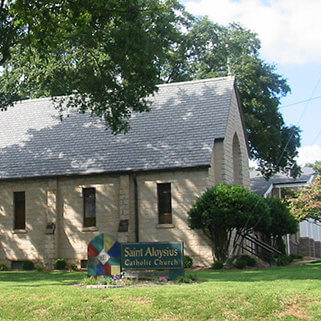
St. James Catholic Church
West Hamlet Avenue, Hamlet St. James is the oldest parish in the Albemarle Vicariate. In the early years of the 20th century, visiting priests from Southern Pines, Fayetteville and Wilmington ministered to the few Catholics in Richmond and Scotland counties in their homes. In 1910, one priest led the effort to build the church in Hamlet that came to be known as St. James Church, the parish that lies in the southeasternmost corner of the diocese. Father William B. Hannon traveled north in search of donations to build the church. He was successful not only in attaining funds for construction, but he also helped acquire the stained glass windows that still adorn the present church. In 1910, Benedictine Abbot Leo Haid, apostolic vicar of North Carolina, dedicated the new church and placed it under the patronage of St. James the Greater. The parish also maintains one of the oldest Catholic cemeteries in the diocese. Located in Ghio and now known as the Scholl Family Cemetery, it dates from a former mission on the site, St. Francis Xavier, that began around 1890 when a German immigrant named Francis Scholl donated 3 acres on the Scotland/Richmond County border for a church and cemetery.
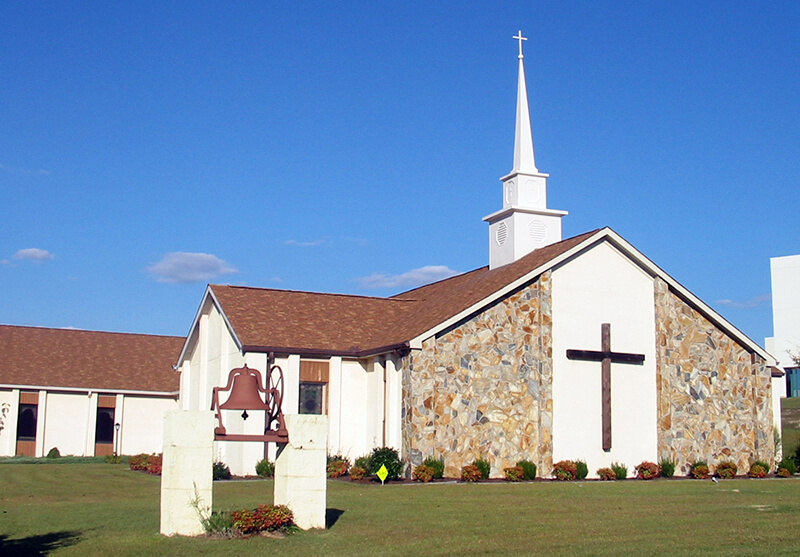
St. John the Evangelist Catholic Church
Church Street, Waynesville St. John the Evangelist is the oldest parish in the Smoky Mountain Vicariate. It dates back to 1925 when a house was purchased for the celebration of Mass. A little over a decade later, a church was constructed across the street from the house. St. John’s also formerly ran a Catholic high school and a grade school – a unique feature in a parish of the diocese – with Franciscan sisters from Wisconsin who arrived in 1939 to teach there. Through the 1950s, the parish clergy began ministering to more and more Catholics throughout North Carolina’s westernmost counties. From 1951, the parish became responsible for missions in Fontana, Murphy, Franklin, Canton and Sylva. Several became parishes in later years. As a result, it is the “mother church” of Catholics living west of Asheville.
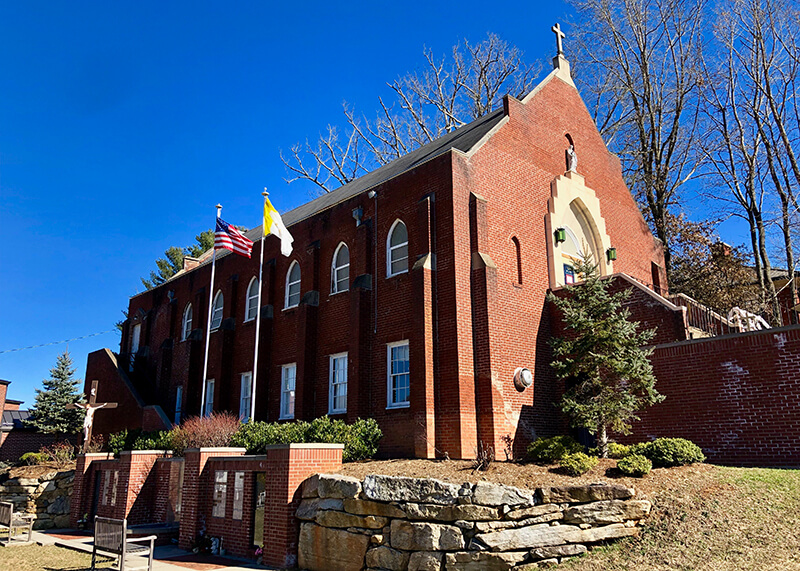
St. Lucien Catholic Church
Summit Avenue, Spruce Pine St. Lucien Parish is the oldest in the Boone Vicariate. Few Catholics lived in the sparsely populated Spruce Pine area in the 1920s, until one of the faithful invited a priest from across the nearby border in Tennessee to offer regular Masses in the remote mountain town. Masses continued to be celebrated over the years at a local hotel by missionary priests until 1935, when Raleigh Bishop William J. Hafey received a gift of property from a New York donor, on which the present church still stands. Originally named St. Bernadette, it became the first Catholic church to serve Mitchell, Avery and Yancey counties. Construction for a new church began in 1939 and was renamed St. Lucien at the request of the principal donors who gave their gift to the parish in remembrance of their daughter, Lucien.
